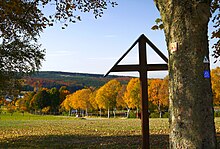Gonzerath
|
Gonzerath
Association-free municipality of Morbach
|
||
|---|---|---|
| Coordinates: 49 ° 51 ′ 27 ″ N , 7 ° 6 ′ 57 ″ E | ||
| Height : | 456 m above sea level NHN | |
| Residents : | 1190 (2010) | |
| Incorporation : | December 31, 1974 | |
| Postal code : | 54497 | |
| Area code : | 06533 | |
|
Location of Gonzerath in Rhineland-Palatinate |
||
Gonzerath is a village in the Hunsrück and the second largest local district in the municipality of Morbach in the Bernkastel-Wittlich district in Rhineland-Palatinate . Until the end of 1974 Gonzerath was an independent municipality .
geography
Gonzerath is located north of the Hunsrückhöhenstraße between the capital Morbach and Bernkastel-Kues on the Moselle . The federal highway 269 runs through Gonzerath .
The Gonzerather -Hinterbach and Longkamperhinterbach residential areas also belong to Gonzerath.
history
Gonzerath, which was first mentioned in 1290, when the Archbishop of Trier, the Vogt Johann Hunolstein tithes of Gonzerath to feud was, had risen in 1787 only 215 inhabitants and was only in 1836 to parish. Until this year the place was always a branch of the parish bishop's throne. A chapel by “Guntzerod” is mentioned in a decree of Trier Archbishop Kuno von Falkenstein in 1374. The chapel suffered severe damage during the Thirty Years War . In 1716 the chapel was rebuilt; In 1880 it had to give way to the new building of today's church.
In Gonzerath, a few older people can still speak the Rotwelsch , also called Jenisch . It used to be the language of cattle dealers, tinkers and broom makers. And "Besenbinner" ("Besenbinner") was also the nickname of the Gonzeraths, because for a long time the village was a center of basket weaving, a trade that was mainly practiced by Yeniche who made the baskets in winter and which they used in summer on trade trips sold themselves. The term “Besenbinner” is still known far and wide today - and the Gonzerather are now relaxed and self-deprecating about their once unloved nickname.
The town's coat of arms depicts an Antonius cross and a seven-leaf beech branch on a two-part, green-silver background. The Antonius Cross stands for the hermit and patron saint of agriculture and livestock farming, Saint Anthony. He is the parish priest of Gonzerath. The beech branch refers to the famous king beech, a symbol of Gonzerath.
present
In 2007, the town of Gonzerath was in the focus of public interest because the NPD party, which was rated by the Office for the Protection of the Constitution , wanted to set up a training center in the former school building there.
On March 3, 2007, a demonstration against the planned measure took place with around 2000 participants. Due to this, the inauguration ceremony of the training center planned for this day was canceled and postponed to May 12, 2007.
However, because the previous owner was unable to meet the requirements to convert the house into a functional office and residential building, the Morbach community made use of its right of first refusal and bought the building back on March 23, 2007.
Attractions
- The royal beech
The king beech, a red beech, is the landmark of the place. It was placed under nature protection in the 1930s and is more than 200 years old today. A direct hiking trail from the center of the village, called the "King's Route", leads to the natural monument.
- Wederather cross
This cross stands east of the village on Wederather Weg. It was probably once erected as a memorial cross, but there are no sources that confirm exactly why it was placed there.
- Lady Chapel
In Gonzerath it has been a tradition for 125 years to make a pilgrimage to the Mother of God in Klausen once a year. In 1990 the villagers also built a chapel in their place in honor of the holy Mother of God, which is consecrated to the Mother of God.
- Schackberg Cross
The cross on the Schackberg, erected in 1930, once served as a symbol of a Catholic village. Today a hiking trail leads up the mountain, from which one can enjoy a view over the whole place.
- Parish church
There was a chapel in this place before the church was built. In 1880 the chapel had to give way to today's church.
- War memorial
Immediately next to the parish church there is a war memorial, which was erected by those who returned from the First World War for the fallen.
politics
The interests of the Gonzerath local district are represented by a local advisory board and a local councilor.
Clubs and activities
- SV Gonzerath 1919 e. V.
- Friends of the Gonzerath Volunteer Fire Brigade
- Youth group "Die Besenbinner"
- Gonzerather Carnival Association "Hejele" 1964 e. V.
- Rifle Corps "Haardtkopf" e. V.
- Gonzerath homeland association
- MGV 1923 Liederkranz
- Gonzerath marching band
Neighboring places
| Annenberg | Come | Götzeroth |
| Gornhausen |

|
Wederath |
| Heinzerath | Morbach | Dog home |
Individual evidence
- ↑ Official municipality directory 2006 ( Memento from December 22, 2017 in the Internet Archive ) (= State Statistical Office Rhineland-Palatinate [Hrsg.]: Statistical volumes . Volume 393 ). Bad Ems March 2006, p. 187 (PDF; 2.6 MB). Info: An up-to-date directory ( 2016 ) is available, but in the section "Territorial changes - Territorial administrative reform" it does not give any population figures.





